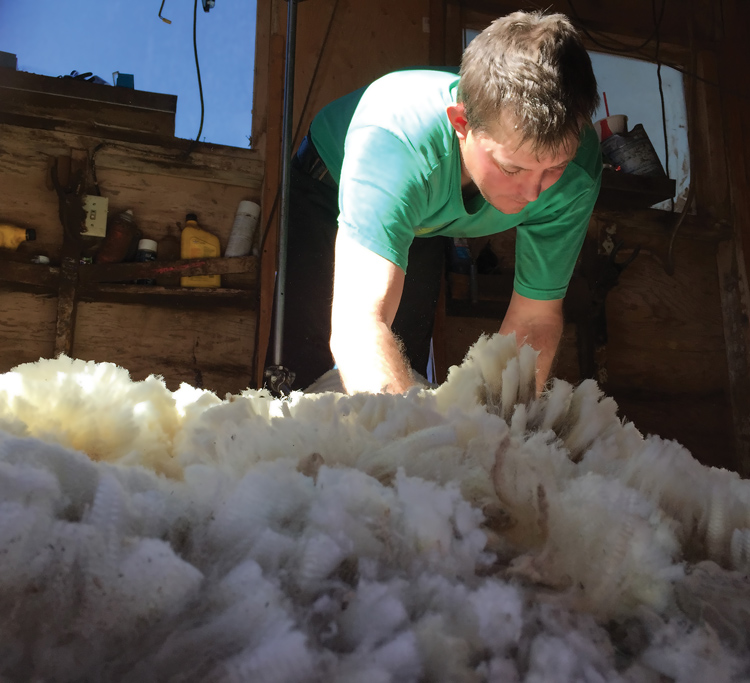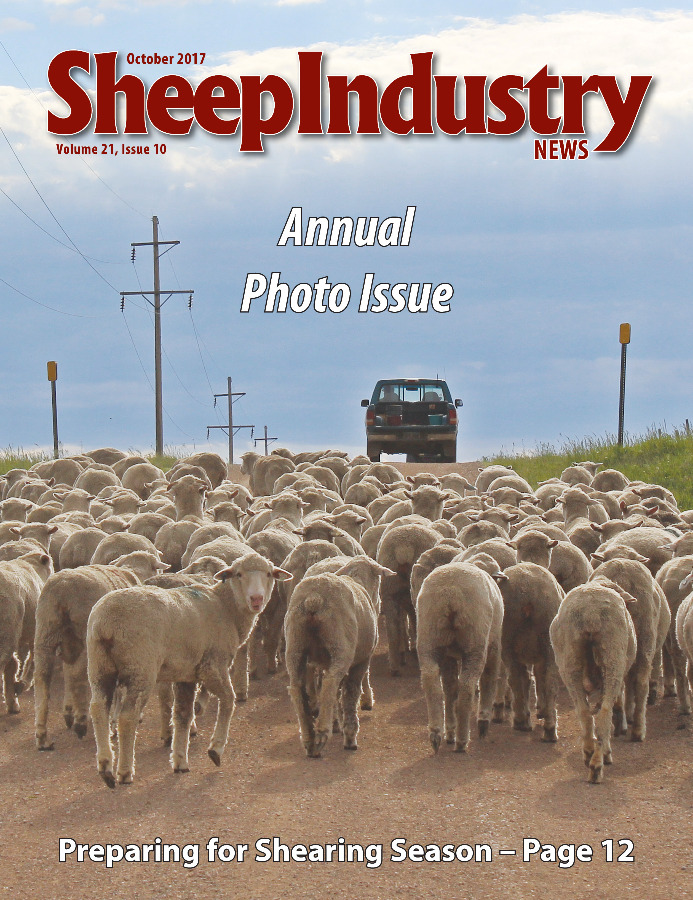Now is the Time to Prepare for 2018 Shearing Season
LISA SURBER, PH.D.
ASI Raw Wool Services Consultant
Are you thinking about shearing yet? Where has the time gone? In only a few months it will be the start of shearing season.
Wool production is a year-round process with quality determined by selection emphasis, management and environment in which the wool is produced. Our sheep spend a year growing the fleece, while the process of harvesting that fleece requires only a few minutes. Wool producers recognize just how much time and planning is devoted to preparing for the harvest.
Here are some suggestions to think about as you prepare for the upcoming shearing season – one of the most important and labor-intensive days in the wool production year.
 The day you turn out your rams is a great time to start thinking about shearing. ASI recommends that you make contact with your shearer or shearing contractor and set your date for shearing during the breeding season. Producers often have their sheep shorn approximately one month before lambing, so the start of the breeding season is the perfect time to plan for shearing. Growers are advised to not shear when ewes are too heavily pregnant, as this will be more stressful for the ewes and more difficult for the shearer. It is also a good time to discuss needs for facilities, labor and number of sheep to be shorn in a day.
The day you turn out your rams is a great time to start thinking about shearing. ASI recommends that you make contact with your shearer or shearing contractor and set your date for shearing during the breeding season. Producers often have their sheep shorn approximately one month before lambing, so the start of the breeding season is the perfect time to plan for shearing. Growers are advised to not shear when ewes are too heavily pregnant, as this will be more stressful for the ewes and more difficult for the shearer. It is also a good time to discuss needs for facilities, labor and number of sheep to be shorn in a day.
The day before shearing, sheep should be penned in clean, contamination-free pens. According to the 2017 revised edition of the Sheep Care Guide, sheep should be held off of feed and water for a period of at least six hours – preferably 12 hours – prior to shearing. Emptying sheep can be a controversial issue for producers and shearers, and can be cause for strife.
Growers worry that prolonged periods off feed prior to shearing can affect the growth and development of unborn lambs and cause metabolic problems in ewes when they are shorn in late pregnancy. New Zealand research indicates no detrimental effect on ewe performance, lamb birth weight or newborn lamb survival after a 24- to 30-hour period of fasting prior to a mid-pregnancy shearing. However, considerable care must be taken to ensure that no sheep to be shorn exceed the recommended number of hours without feed and water (in most publications that number is somewhere around 20 to 24 hours, and generally applies to pregnant ewes in average body condition about one month prior to lambing).
The closer a producer is to lambing, the less time ewes can be off feed and water. Shearers are concerned that full sheep add to the already heavy drag-out weight of many ewes. The gut contents of a 160-pound ewe can be about 20 percent of her body weight (or about 32 pounds). A shearer that shears 150 ewes in a day will potentially lift, drag and move as much as an additional 2.4 tons of extra weight in a single day.
Also, sheep that have full rumens and bladders in addition to fetal weight are uncomfortable and might kick and struggle more during shearing. If catch pens are used, full sheep make pens and the shearing floor more unsafe, as sheep will pass more feces and urine.
Be watchful of upcoming weather conditions around your selected shearing date. Sheep need protection from poor weather before and especially after shearing. Ideally, sheep holding pens are covered so that the sheep remain dry in case of snow or rain. Wet wool should never be shorn. The wool will lose value or be destroyed if it is packaged wet. Wet sheep can also pose a health and safety hazard for shearers.
With regard to sorting sheep, the grower is advised to sort the flock in order to separate the following groups in advance of shearing: lambs, yearlings, rams and ewes by wool type, fiber diameter, fiber length and style. Meat or mutton-type, black, colored or spotted sheep should be isolated and shorn as the very last group. Talk to your wool marketing warehouse, agent or buyer prior to shearing so that you know what needs to be done in order to increase the value of your wool. Ask if there are any specific guidelines you can follow to improve your shearing day and your overall wool clip that are specific to current market conditions or customers. Moreover, the ASI Market News App offers a wool calculator tool to help producers examine current wool pricing appropriate for their grade and yield.
Anything that is not wool is a contaminant, and focusing on reducing contamination during the entire production year (not just shearing day) is essential from a producer perspective. Sources of contamination in American wools, such as poly, paint and hair, continue to challenge wool processors. If these items are not kept out of the raw wool, they are often found at the manufacturing level, where the cost to process increases. This means your wool is less profitable to the processor due to costly removal of foreign fibers, slow processing, contaminating equipment or limited end-use to a lower-valued product.
Wools noted to have poly, excessive paint or hair might receive sizable discounts to cover the removal expense at the processor/manufacturer level. Sources of poly are reported to be not only from hay bales, but round bale net wrap, white poly grain totes and blue plastic tarps. White poly grain totes are never a substitute for approved wool packaging. Shearers or growers should not use plastic tarps in or around the shearing floor, as the fibers begin to fray and can be a serious contaminant to wool.
Applied sources of wool contamination – such as branding fluids and topical treatments for external parasites – are still commonly used across the United States. Paint free wool should be your first consideration, as it has been proven to preferred by processors. Many mills, particularly woolen mills such as Pendleton continue to seek paint-free wool. The absence of paint might be the difference between earning market price or selling your wool at a discount.
If sheep must be branded:
• Use only approved scourable marking fluids.
• Avoid branding just prior to shearing time.
• Use a medium-size paint applicator that does not exceed 4 millimeters in width.
Other contaminants are hair and kemp fibers. Hair can come from shedding sheep, their crosses and kemp, but also from top knots, leg hair, shanks and hairy britches. Shearers and wool handlers should be mindful in sorting off these sources of contamination on the shearing floor.
Metal tags are still a hot topic among producers and shearers alike and can cause shearer injury. The National Scrapie Eradication Program (administered by the U.S. Department of Agriculture’s Animal and Health Plant Inspection Service) provides free ear tags to sheep and goat producers. Previously, both plastic and metal tags have been available. Due to federal budget restrictions beginning on Oct. 1, APHIS plans to offer only metal tags. Producers do, however, have an option to purchase plastic eartags from approved tag companies.
ASI policy recognizes that metal tags pose a danger to shearers in that many times they are difficult to see. If the shearing comb catches the hard-to-see tag, it can cause the shearing handpiece to take a random and potentially dangerous bounce resulting in injury to the shearer or the sheep. In order to prevent injury, it has been recommended that producers use plastic scrapie tags instead of the metal tags. Tag placement also is very important. It has been recommended by the sheep industry that the scrapie eartag be placed in the left ear when standing behind the animal. Ideal placement would have the tag inserted into the middle to the outside of the ear – not close to the head – where it is more visible, preventing the tag from being caught in the comb and locking up the cutter.
Shearing sheep and handling wool is hard work, so take good care of your shearers and their helpers. This is also very important if you want to establish a long-term business relationship with your shearer. A good hot meal will do wonders for a hard-working person and help increase performance for the remainder of the day. Nothing is worse for a shearer than showing up to a job and finding that there will be no meal or break provided. It is hard to perform at optimal levels on an empty stomach. Remember, a day’s shearing is the physical equivalent of running a marathon.
Be prepared for unforeseen events. Your shearing contractor could arrive with more or less shearers than anticipated. This might mean shearing will speed up or slow down. Can you adapt? Do you have restroom facilities available? Will the crew need power for the shearing machines, trailer or campers? The key to all these questions is good communication, careful planning and encouraging a strong working relationship between the sheep producer and the shearer in all aspects of shearing management.
Lastly, we as an industry need to think about how we can address the seasonal shortage of shearers. Can you move your shearing day earlier or later in the season?
This might help shearing contractors make better use of foreign shearers and labor. ASI continues to support advanced shearer training and beginning and intermediate shearing schools across the United States. The association is also working to complete a revision of the shearing manual for fall 2017.
With fewer shearing crews and shearers available – both domestic and foreign – producers will find it beneficial to do everything possible to complete shearing day with minimal stress on the sheep, working help and shearing crew.


